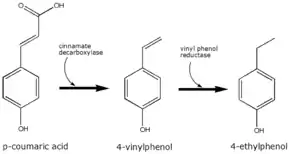p-Coumaric acid
p-Coumaric acid is a hydroxycinnamic acid, an organic compound that is a hydroxy derivative of cinnamic acid. There are three isomers of coumaric acid—o-coumaric acid, m-coumaric acid, and p-coumaric acid—that differ by the position of the hydroxy substitution of the phenyl group. p-Coumaric acid is the most abundant isomer of the three in nature. p-Coumaric acid exists in two forms trans-p-coumaric acid and cis-p-coumaric acid.
 | |
 | |
| Names | |
|---|---|
| Preferred IUPAC name
(2E)-3-(4-Hydroxyphenyl)prop-2-enoic acid | |
| Other names
(E)-3-(4-Hydroxyphenyl)-2-propenoic acid (E)-3-(4-Hydroxyphenyl)acrylic acid para-Coumaric acid 4-Hydroxycinnamic acid β-(4-Hydroxyphenyl)acrylic acid | |
| Identifiers | |
3D model (JSmol) |
|
| 2207383 | |
| ChEBI | |
| ChEMBL | |
| ChemSpider | |
| DrugBank | |
| ECHA InfoCard | 100.116.210 |
| EC Number |
|
| 2245630 | |
| KEGG | |
PubChem CID |
|
| UNII | |
CompTox Dashboard (EPA) |
|
| |
| |
| Properties | |
| C9H8O3 | |
| Molar mass | 164.160 g·mol−1 |
| Melting point | 210 to 213 °C (410 to 415 °F; 483 to 486 K) |
| Hazards | |
| GHS pictograms |    |
| GHS Signal word | Danger |
| H301, H302, H311, H314, H315, H317, H319, H335 | |
| P260, P261, P264, P270, P271, P272, P280, P301+310, P301+312, P301+330+331, P302+352, P303+361+353, P304+340, P305+351+338, P310, P312, P321, P322, P330, P332+313, P333+313, P337+313, P361, P362, P363 | |
Except where otherwise noted, data are given for materials in their standard state (at 25 °C [77 °F], 100 kPa). | |
| Infobox references | |
It is a crystalline solid that is slightly soluble in water, but very soluble in ethanol and diethyl ether.
Natural occurrences
p-Coumaric acid can be found in Gnetum cleistostachyum.[1]
In food
p-Coumaric acid can be found in a wide variety of edible plants and fungi such as peanuts, navy beans, tomatoes, carrots, basil and garlic. It is found in wine and vinegar.[2] It is also found in barley grain.[3]
Derivatives
p-Coumaric acid glucoside can also be found in commercial breads containing flaxseed.[5]
Diesters of p-coumaric acid can be found in carnauba wax.
Metabolism
Biosynthesis
It is biosynthesized from cinnamic acid by the action of the P450-dependent enzyme 4-cinnamic acid hydroxylase (C4H).
It is also produced from L-tyrosine by the action of tyrosine ammonia lyase (TAL).

 + NH3 + H+
+ NH3 + H+
Biosynthetic building block
p-Coumaric acid is the precursor of 4-ethylphenol produced by the yeast Brettanomyces in wine. The enzyme cinnamate decarboxylase catalyzes the conversion of p-coumaric acid into 4-vinylphenol.[6] Vinyl phenol reductase then catalyzes the reduction of 4-vinylphenol to 4-ethylphenol. Coumaric acid is sometimes added to microbiological media, enabling the positive identification of Brettanomyces by smell.
 The conversion of p-coumaric acid to 4-ethyphenol by Brettanomyces
The conversion of p-coumaric acid to 4-ethyphenol by Brettanomyces
cis-p-Coumarate glucosyltransferase is an enzyme that uses uridine diphosphate glucose and cis-p-coumarate to produce 4′-O-β-D-glucosyl-cis-p-coumarate and uridine diphosphate (UDP). This enzyme belongs to the family of glycosyltransferases, specifically the hexosyltransferases.[7]
Phloretic acid, found in the rumen of sheep fed with dried grass, is produced by hydrogenation of the 2-propenoic side chain of p-coumaric acid.[8]
The enzyme, resveratrol synthase, also known as stilbene synthase, catalyzes the synthesis of resveratrol ultimately from a tetraketide derived from 4-coumaroyl CoA.[9]
p-Coumaric acid is a cofactor of photoactive yellow proteins (PYP), a homologous group of proteins found in many eubacteria.[10]
See also
References
- Yao CS, Lin M, Liu X, Wang YH (April 2005). "Stilbene derivatives from Gnetum cleistostachyum". Journal of Asian Natural Products Research. 7 (2): 131–7. doi:10.1080/10286020310001625102. PMID 15621615.
- Gálvez MC, Barroso CG, Pérez-Bustamante JA (1994). "Analysis of polyphenolic compounds of different vinegar samples". Zeitschrift für Lebensmittel-Untersuchung und -Forschung. 199: 29–31. doi:10.1007/BF01192948.
- Quinde-Axtell Z, Baik BK (December 2006). "Phenolic compounds of barley grain and their implication in food product discoloration". Journal of Agricultural and Food Chemistry. 54 (26): 9978–84. doi:10.1021/jf060974w. PMID 17177530.
- Mao W, Schuler MA, Berenbaum MR (May 2013). "Honey constituents up-regulate detoxification and immunity genes in the western honey bee Apis mellifera". Proceedings of the National Academy of Sciences of the United States of America. 110 (22): 8842–6. Bibcode:2013PNAS..110.8842M. doi:10.1073/pnas.1303884110. PMC 3670375. PMID 23630255.
- Strandås C, Kamal-Eldin A, Andersson R, Åman P (October 2008). "Phenolic glucosides in bread containing flaxseed". Food Chemistry. 110 (4): 997–9. doi:10.1016/j.foodchem.2008.02.088. PMID 26047292.
- "Brettanomyces Monitoring by Analysis of 4-ethylphenol and 4-ethylguaiacol". etslabs.com. Archived from the original on 2008-02-19.
- Rasmussen S, Rudolph H (1997). "Isolation, purification and characterization of UDP-glucose: cis-p-coumaric acid-β-D-glucosyltransferase from sphagnum fallax". Phytochemistry. 46 (3): 449–453. doi:10.1016/S0031-9422(97)00337-3.
- Chesson A, Stewart CS, Wallace RJ (September 1982). "Influence of plant phenolic acids on growth and cellulolytic activity of rumen bacteria". Applied and Environmental Microbiology. 44 (3): 597–603. PMC 242064. PMID 16346090.
- Wang, Chuanhong; Zhi, Shuang; Liu, Changying; Xu, Fengxiang; Zhao, Aichun; Wang, Xiling; Ren, Yanhong; Li, Zhengang; Yu, Maode (2017). "Characterization of Stilbene Synthase Genes in Mulberry (Morus atropurpurea) and Metabolic Engineering for the Production of Resveratrol in Escherichia coli". Journal of Agricultural and Food Chemistry. 65 (8): 1659–1668. doi:10.1021/acs.jafc.6b05212. PMID 28168876.
- Hoff WD, Düx P, Hård K, Devreese B, Nugteren-Roodzant IM, Crielaard W, Boelens R, Kaptein R, van Beeumen J, Hellingwerf KJ (November 1994). "Thiol ester-linked p-coumaric acid as a new photoactive prosthetic group in a protein with rhodopsin-like photochemistry". Biochemistry. 33 (47): 13959–62. doi:10.1021/bi00251a001. PMID 7947803.
